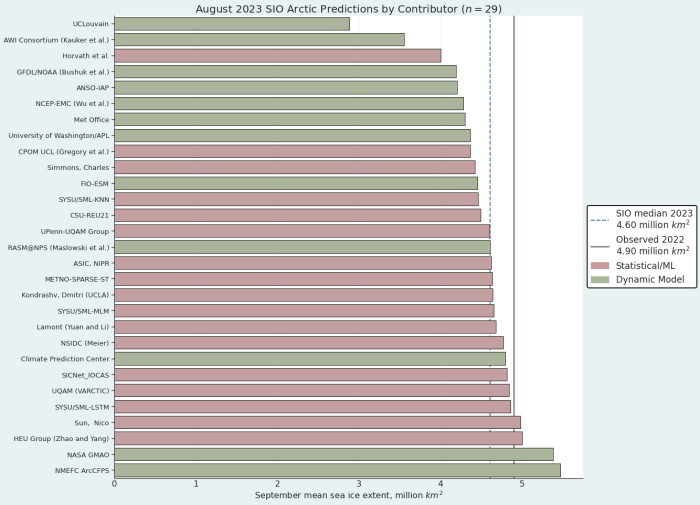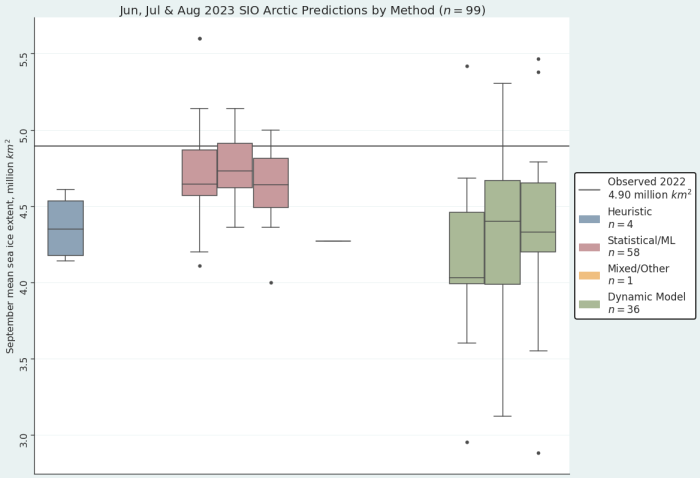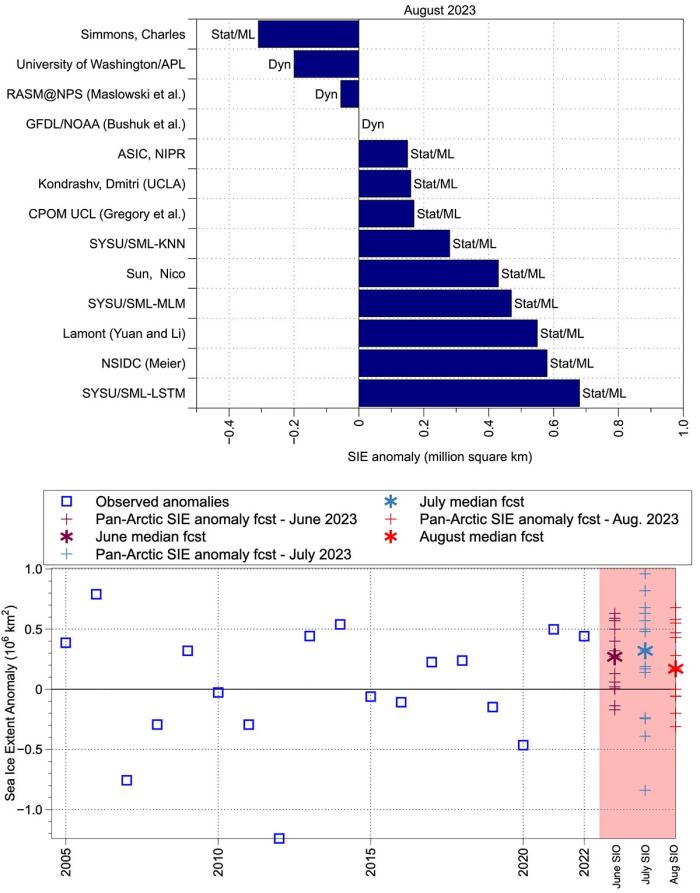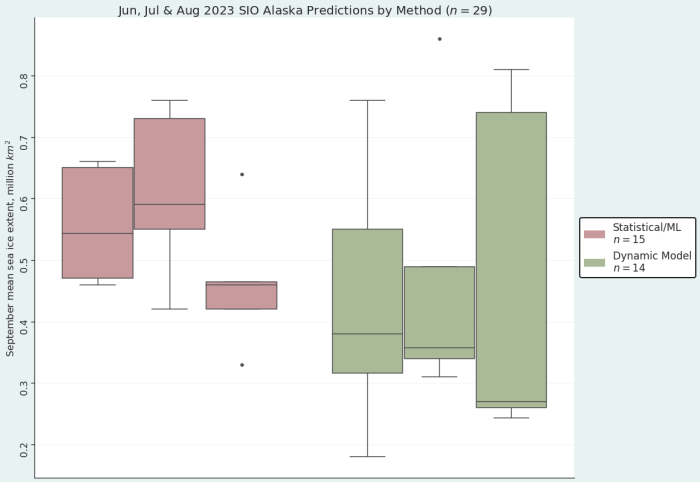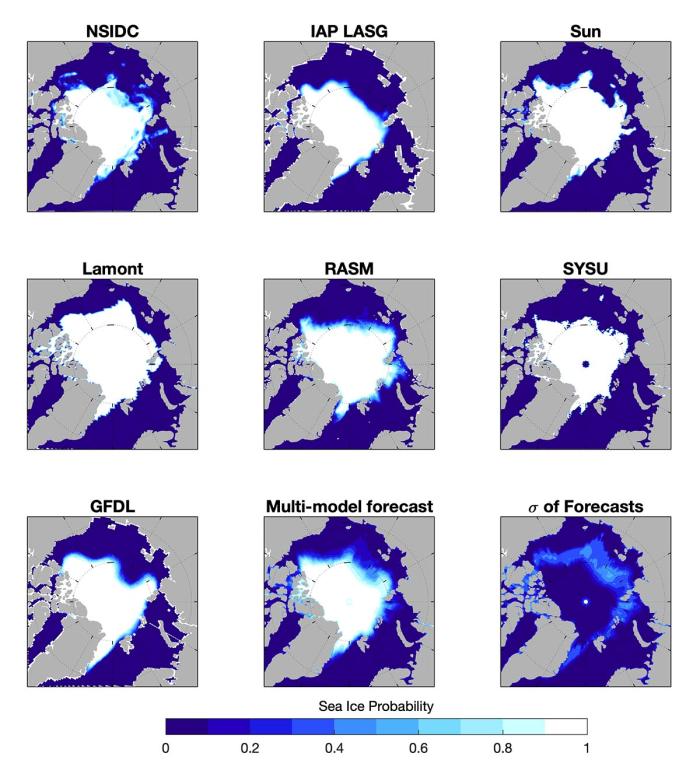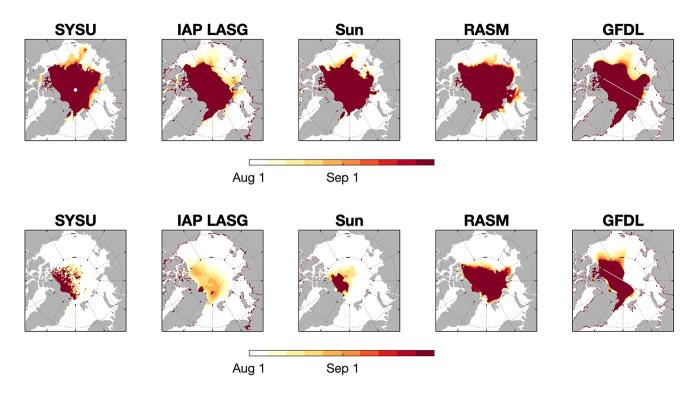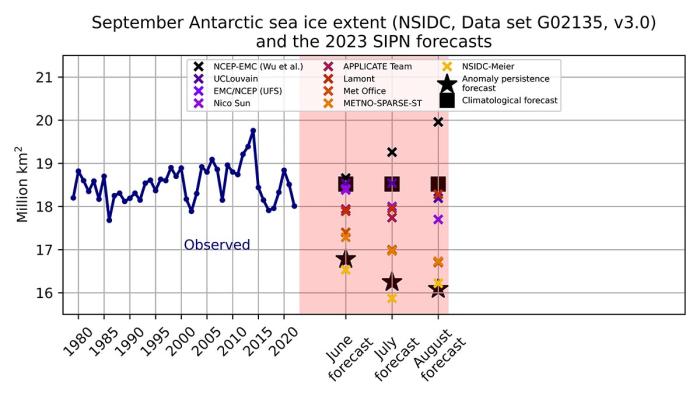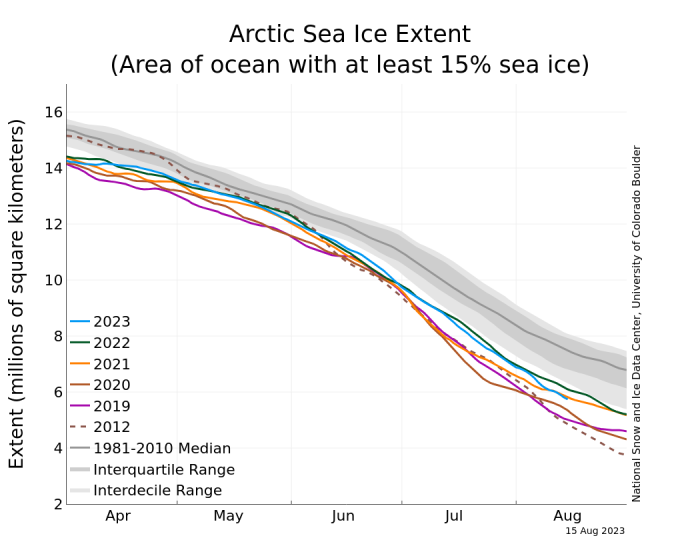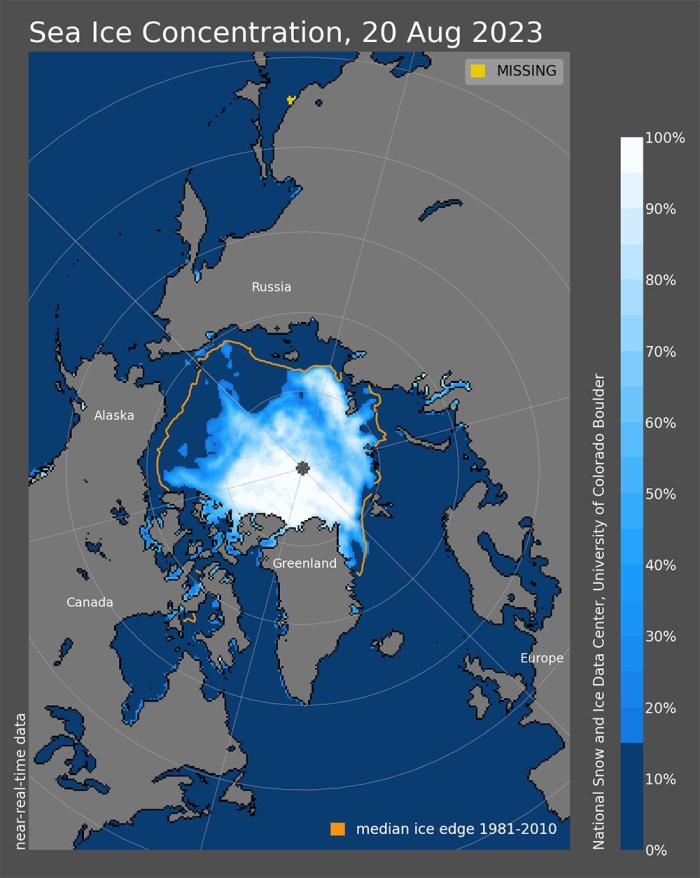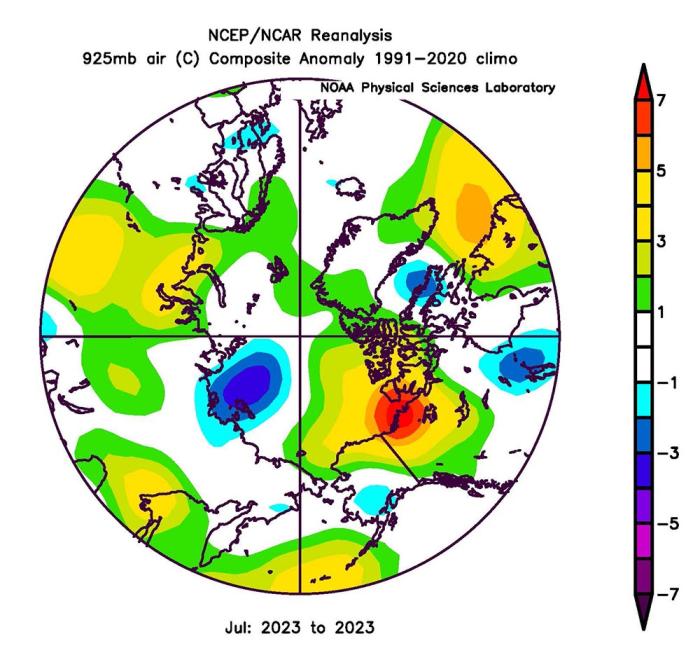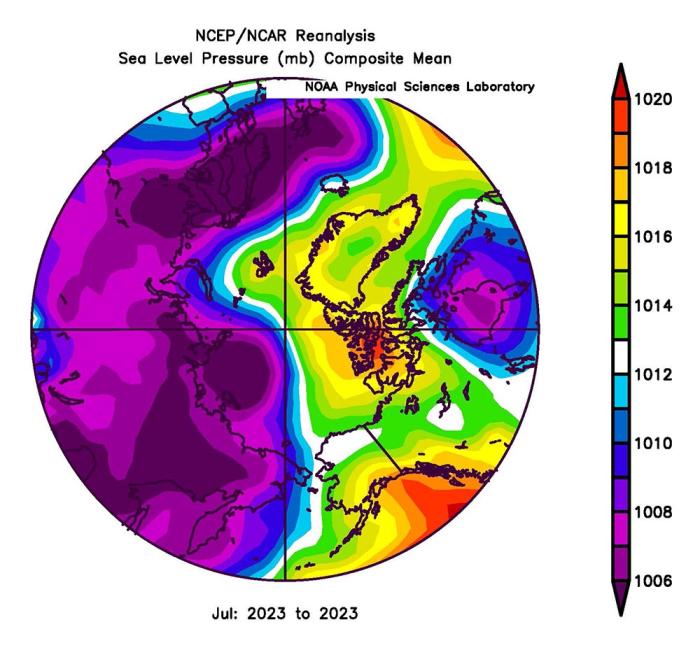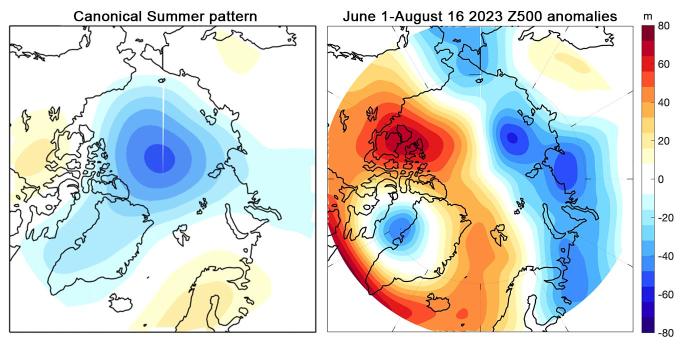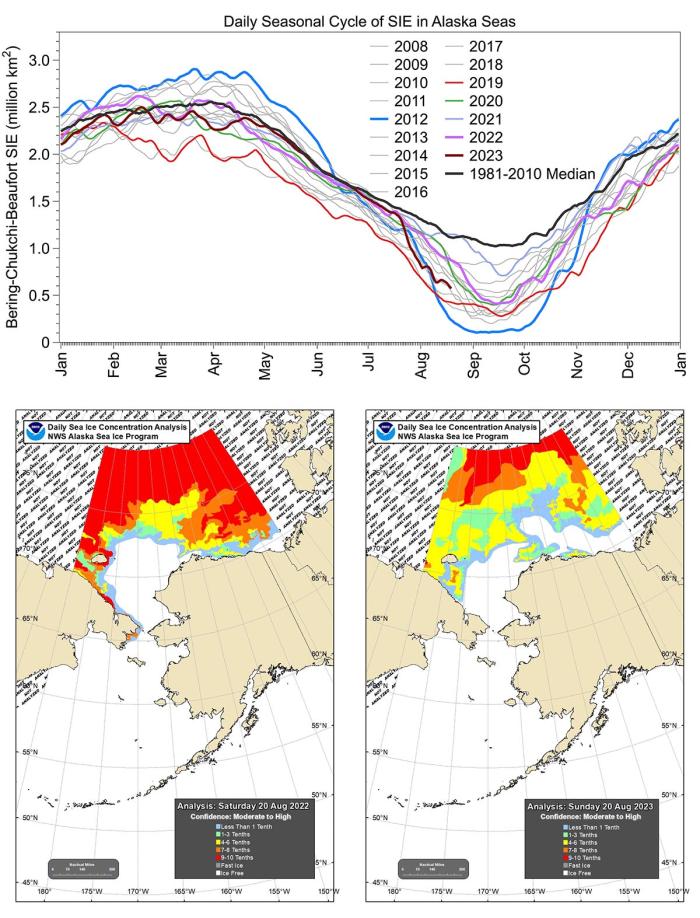Outlook Report
Executive Summary
We thank all the groups and individuals who submitted August Outlooks in this 16th year of the Sea Ice Outlook. We also thank NSF for supporting this year's Outlook with funds from NSF award #1331083.
This month we received 29 September pan-Arctic sea-ice extent forecasts. Of these, 10 included regional Alaska sea ice extent forecasts, and 7 included Antarctic sea-ice extent forecasts. The August median forecasted value for pan-Arctic September sea-ice extent is 4.60 million square kilometers with interquartile values of 4.35 and 4.80 million square kilometers, while individual forecasts range from 2.88 to 5.47 million square kilometers. We note that the lowest two forecasts predict a new record September sea-ice extent value (current record is September 2012, with a sea-ice extent of 3.57 million square kilometers), but these forecasts are outliers relative to the other contributions.
The median Alaska sea-ice extent forecast is 0.44 million square kilometers and the median Antarctic sea-ice extent forecast is 17.70 million square kilometers, which would be the second lowest Antarctic September sea-ice extent on record. Three of the seven Antarctic forecasts predict a record low sea-ice extent (see below for further details).
The August median forecast of 4.60 million square kilometers is slightly lower than the July median (4.66) and slightly higher than the June median (4.54). Interestingly, the interquartile range of August forecasts is slightly higher than the July interquartile range (0.45 compared to 0.36 million square kilometers), illustrating that inter-model uncertainty was not reduced between early July and early August forecasts. The August interquartile range is narrower than the June interquartile range of 0.56 million square kilometers.
We also received 13 forecasts of the September Arctic sea-ice extent anomaly. The median anomaly sea-ice extent forecast is +0.17 million square kilometers, suggesting that September 2023 sea-ice extent will be slightly above the expected long term linear trend value. Anomaly forecasts range from -0.31 million square kilometers to +0.68 million square kilometers, and the interquartile range is 0.50 million square kilometers, slightly greater than the interquartile range for absolute September sea-ice extent mentioned above.
Nine groups submitted supplemental materials (see: Contributor Full Reports and Supplemental Materials below). The supplemental material contents vary among the contributions, but they may include additional figures and information on methodology including (1) how the forecasts are produced; (2) number of ensemble members used in the forecasts; (3) whether and how bias-corrections are applied; (4) ensemble spread, range of forecasts, uncertainties and other statistics; and (5) whether or not post-processing was performed.
This August Outlook Report was developed by lead author Mitch Bushuk, NOAA's Geophysical Fluid Dynamics Laboratory (Executive Summary, Overview of pan-Arctic forecasts), Edward Blanchard-Wrigglesworth, University of Washington (discussion of predictions from spatial fields), Walt Meier, National Snow and Ice Data Center (Discussion of current Arctic conditions); with contributions from Uma Bhatt, University of Alaska Fairbanks (Overview of Alaska regional forecasts, discussion of pan-Arctic anomaly sea-ice forecasts and ice conditions in the Bering and Chukchi seas); François Massonnet, Université catholique de Louvain (Discussion of Antarctic contributions); and with input from Matthew Fisher and the NSIDC Development Team, (statistics and graphs); Betsy Turner-Bogren and Helen Wiggins, ARCUS (report coordination and editing).
Note: The Sea Ice Outlook provides an open process for those who are interested in Arctic sea ice to share predictions and ideas; the Outlook is not an operational forecast.
See: August Call for Contributions
2023 SIO Forecasts (Pan-Arctic, Alaska Region, Spatial Forecasts, and Antarctic)
Pan-Arctic Sea-Ice Forecasts
The August 2023 Outlook received 29 pan-Arctic contributions (Figure 1). This year's median forecasted value for pan-Arctic September sea-ice extent is 4.60 million square kilometers with interquartile values of 4.35 and 4.80 million square kilometers. This is lower than last year's August median forecast for September, but higher than the three previous years (2019–2021). The lowest sea-ice extent forecast is 2.88 million square kilometers, from UC Louvain, which would be a new record low for the satellite period (1979-present); the highest sea-ice extent forecast is 5.47 million square kilometers, from the NMEFC ArcCFPS Group, which would be the highest September extent since 2006. Two of the outlooks forecast a new record minimum September extent (UC Louvain and the AWI Consortium), with UC Louvain predicting a notable record and AWI Consortium forecasting a value close to the 2012 record low of 3.57 million square kilometers. The observed extent values are from the NSIDC Sea Ice Index (Fetterer et al., 2017), based on the NASA Team algorithm sea ice concentration fields distributed by the NASA Snow and Ice Distributed Active Archive Center (DAAC) at NSIDC (DiGirolamo et al., 2022; Meier et al., 2021).
There are 12 dynamical model contributions and 17 contributions from statistical models. The dynamical models have a median forecast of 4.33 million square kilometers with an interquartile range of 4.20 to 4.70 million square kilometers (Figure 2). Compared to the dynamical models, the statistical models generally predict higher values, with a median forecast of 4.64 million square kilometers and an interquartile range of 4.48 to 4.82 million square kilometers. The Outlooks from all methods have medians and interquartile values below last year's observed September extent (4.90), with only a handful of methods yielding an extent higher than last year (Figure 2).
Pan-Arctic Sea-Ice Extent Anomalies
This is the third year that the SIO has solicited forecasts of September mean sea-ice extent anomalies. The pan-Arctic anomaly is the departure of the contributors' September extent Outlook relative to their adopted baseline trend (e.g., the trend in historical observations, model hindcasts, etc.). This is motivated by the prospect of reducing SIO extent forecast uncertainty that may originate from models having different trends, mean states, and post-processing methodologies. The 13 anomaly forecasts range from -0.31 to +0.68 million square kilometers, with four at or below and 9 above the contributors' baseline (Figure 3 top). The observed anomalies range from -1.24 (2012) to 0.79 (2006) million square kilometers (Figure 3 bottom). The pan-Arctic 2023 August SIO anomaly forecast has a median of +0.17 million square kilometers and an interquartile range of 0.50 million square kilometers. The uncertainty in the August SIO anomaly forecasts matches that in June, both of which are smaller than the large spread in July. Similar to the pan-Arctic forecasts, statistical methods generally predict higher positive anomalies than dynamical methods.
Alaska Regional Forecasts
The multimodel median for the August 2023 SIO forecast for the Alaska seas is 0.44 million square kilometers, and ranges from a minimum of 0.24 to a maximum of 0.81 million square kilometers (Figure 4). The dynamical model forecasts range from a minimum of 0.24 to maximum 0.81 million square kilometers with a median of 0.27 million square kilometers. The statistical model forecasts range from a minimum of 0.33 to a maximum of 0.64 million square kilometers with a median of 0.46 million square kilometers. The statistical forecasts display a smaller spread (interquartile range of 0.05) compared to the dynamical models (interquartile range of 0.48) (Figure 5). To place these in historical perspective, the September median sea-ice extent for the Alaska seas (Bering, Chukchi, and Beaufort) over 2007–2022 is 0.44 million square kilometers, making the forecast for August 2023 SIO forecast match the observed median value (see Figure 3 of 2022 Postseason SIO report).
Pan-Arctic Forecasts with Spatial Methods
We received seven forecasts of September sea-ice probability (SIP), and five of ice-free date (IFD, using both a 15% and an 80% sea-ice concentration threshold).
The SIP forecasts are in general similar to those in July, with a slight reduction in uncertainty. Interestingly, the forecasts show relatively high SIP values in the Laptev sea (with the exception of the IAP LASG forecast), which in recent years has often undergone significant melt. In contrast, the East Siberian 'sea ice tongue' is forecasted to mostly melt out or show reduced cover.
The IFD forecasts show that we are near the end of the melt season, with relatively small additional loss of sea ice (shown by the reduced covers of IFD during August or September). These forecasts however help understand the differences across models in their SIP forecasts above. For example, IAP LASG forecasts melt the ice cover during August around the Laptev sea, whereas other models' forecasts maintain the ice cover in this region.
Regarding the IFD80 forecasts, there is forecast uncertainty regarding the SIC over the central Arctic region, with some models forecasting significant areas to remain above 80% SIC (GFDL, RASM), whereas others forecast SICs below 80% by the end of summer throughout the central Arctic (e.g., IAP LASG).
This month we received two contributions of SIC and sea ice thickness (SIT) initial conditions (Figure 8).
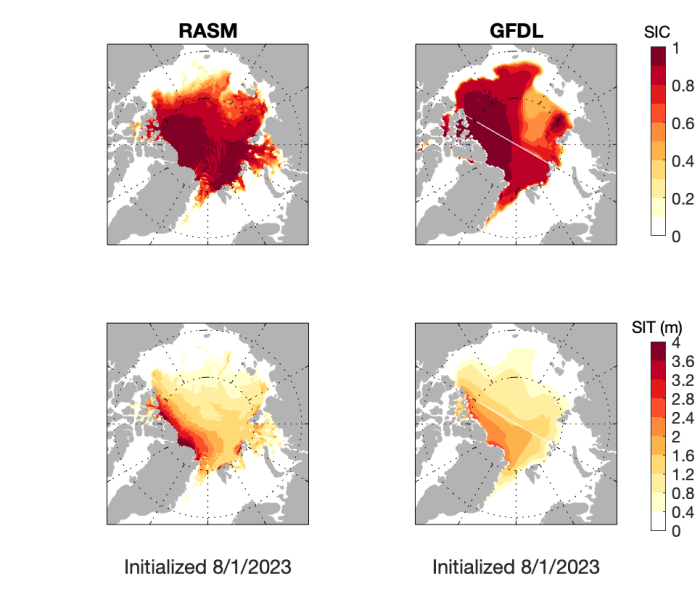
While at large scale there is reasonable agreement in the SIC and SIT ICs, there are also significant differences in particular regions (especially in the Kara and East Siberian seas), which likely help explain some of the SIP and IFD forecast differences between the two models.
Antarctic Forecasts
Seven outlooks were received for this August call. All groups except one (NCEP-EMC) forecast below-average September mean Antarctic sea-ice extent (Figure 9). We note that the NCEP-EMC forecast is not bias corrected, and we place caution in interpreting it – especially given the increase of the predicted Antarctic sea-ice extent with lead time.
On 20 August 2023, the anomaly of daily Antarctic sea-ice extent was 2.2 million square kilometers below the 1981-2020 average, according to the NSIDC sea ice index. This confirms the exceptional behavior of austral sea ice in 2023, that has been following record-low values for eight months.
Last month, we stated that it was more likely than not that Antarctic sea-ice would hit a record low in September. Given the continued slow development of sea ice and the consistent sign of the forecasts, we now turn this level of confidence to "very likely".
Current Conditions
Pan-Arctic Conditions
During the month of July, sea ice extent decline was near average at 93,300 sq km per day and was fairly steady through the month and near-average decline rates continued through mid-August. At the end of July, extent was 12th lowest in the 45-year satellite record. Thus, conditions were not extreme relative to recent years, but continued a trend of much lower summer extent than before 2007.
Note: Figure 10 is from NSIDC Charctic, based on NSIDC Sea Ice Index, Fetterer et al., 2017 and the NASA Team sea-ice concentration product at NSIDC (DiGirolamo et al., 2022; Meier et al., 2021).
The primary areas of loss during the month were in the Beaufort and Chukchi Seas, where the ice edge retreated far from the coast. The ice also retreated in the eastern East Siberian Sea and the Laptev Sea, though at the end of July a tongue of ice extending to near the coast in the western East Siberian Sea remained. Sea ice also extended to the coast of the Taymyr Peninsula, keeping the Northern Sea Route closed. By mid-August, the tongue of ice in the East Siberian Sea had largely eroded, but ice still remained in the proximity of the Taymyr Peninsula. Ice was beginning to clear out of the channels of the Canadian Archipelago by the end of July and by mid-August the Amundsen (southern) route through the Northwest Passage was open and the northern route was also clearing.
Note: For current data, see NSIDC Arctic Sea Ice News and Analysis and NSIDC Sea Ice Index.
Temperatures during July were moderate over most of the Arctic with the exception of very warm conditions in the eastern Beaufort Sea, where air temperatures at the 925 mb level of the atmosphere were up to 7 degrees C above average. Air temperatures over the Laptev Sea were 1 to 3 degrees C below average. Elsewhere, temperatures were near-average.
The July sea-level pressure pattern was marked by low pressure over the Laptev Sea and high pressure centered over the Canadian Archipelago. This dipole-anomaly pattern resulted in a fairly strong pressure gradient across the central Arctic, which led to strengthened winds and greater sea ice transport from the Pacific side of the Arctic toward the Atlantic side.
The 500 hPa ('Z500', about 5.5 kilometers up in the atmosphere) geopotential anomalies for 1 June through 16 August 2023 (calculated from the ERA5 reanalysis) show negative anomalies over the Siberian Arctic and positive anomalies over Svalbard and the CAA (Figure 14). The summer pattern of geopotential height anomalies at 500 hPa that covaries with September sea-ice extent can also help account for forecast uncertainty in SIO forecasts, with summers that have low Z500 anomalies tending to have more sea ice (and forecasts that tend to under-predict SIE) and vice versa (Blanchard-Wrigglesworth et al, 2023). In Figure 14 we show the canonical summer pattern, and the so-far (1 June—16 August) observed pattern of Z500 anomalies for summer 2023.
As we saw in July, the atmospheric pattern during the current summer is mostly orthogonal to the canonical pattern, and thus, to first order, we do not expect the current summer's circulation to strongly impact September pan-Arctic sea ice extent anomalies.
Alaska Regional Conditions
The seasonal cycle of daily sea-ice extent in the Alaskan seas in 2023 remained close to climatology during the melt season until mid-July. Since then, the sea-ice extent has fallen steeply, with mid-August values nearly reaching those from 2019 (Figure 15, top). The 2022 sea ice in the Chukchi was lower than mid-August values in 2023, while it was higher in 2022 than 2023 in the Beaufort. The August Alaska sea ice had lower concentrations in 2023 compared to 2022 (Figure 15, bottom).
References
Blanchard‐Wrigglesworth, E., Bushuk, M., Massonnet, F., Hamilton, L.C., Bitz, C.M., Meier, W.N. and Bhatt, U.S., 2023. Forecast skill of the Arctic Sea ice outlook 2008–2022. Geophysical Research Letters, 50(6), p.e2022GL102531.
DiGirolamo, N., C. L. Parkinson, D. J. Cavalieri, P. Gloersen, and H. J. Zwally. (2022). Sea Ice Concentrations from Nimbus-7 SMMR and DMSP SSM/I-SSMIS Passive Microwave Data, Version 2 [Data Set]. Boulder, Colorado USA. NASA National Snow and Ice Data Center Distributed Active Archive Center. https://doi.org/10.5067/MPYG15WAA4WX. Date Accessed 08-15-2023.
Fetterer, F., K. Knowles, W. N. Meier, M. Savoie, and A. K. Windnagel. (2017). Sea Ice Index, Version 3 [Data Set]. Boulder, Colorado USA. National Snow and Ice Data Center. https://doi.org/10.7265/N5K072F8. Date Accessed 08-20-2023.
Kalnay et al.,The NCEP/NCAR 40-year reanalysis project, Bull. Amer. Meteor. Soc., 77, 437-470, 1996.
Contributor Full Report PDFs and Supplemental Materials
This report was developed by Sea Ice Prediction Network (SIPN) team members.
Report Lead:
Mitch Bushuk, NOAA Geophysical Fluid Dynamics Laboratory (GFDL)
Additional Contributors:
- Edward Blanchard-Wrigglesworth, University of Washington, Department of Atmospheric Sciences
- Uma Bhatt, University of Alaska Fairbanks, Dept. of Atmospheric Sciences, Geophysical Institute, International Arctic Research Center
- Walt Meier, National Snow and Ice Data Center (NSIDC), Cooperative Institute for Research in Environmental Sciences (CIRES) at the University of Colorado, Boulder.
- François Massonnet, Université Catholique de Louvain (Belgium)
- Michael Steel, University of Washington, Applied Physics Laboratory
- Matthew Fisher and the NSIDC Development Team, NSIDC, Cooperative Institute for Research in Environmental Sciences at the University of Colorado Boulder
Editors:
Betsy Turner-Bogren, Arctic Research Consortium of the U.S. (ARCUS), Project Manager
Helen Wiggins, (ARCUS), Executive Director
Suggested Citation:
Bushuk, M., E.Blanchard-Wrigglesworth, W. Meier, U.S. Bhatt, M. Fisher, F. Massonnet, M. Steele, and H. V. Wiggins. Editors: Turner-Bogren, B. and H. V. Wiggins. August 2023. "Sea Ice Outlook: 2023 August Report." (Published online at: https://www.arcus.org/sipn/sea-ice-outlook/2023/august)
This Sea Ice Outlook Report is supported in part by with funds from NSF award #1331083. Any opinions, findings, and conclusions or recommendations expressed in this material are those of the author(s) and do not necessarily reflect the views of the National Science Foundation.


